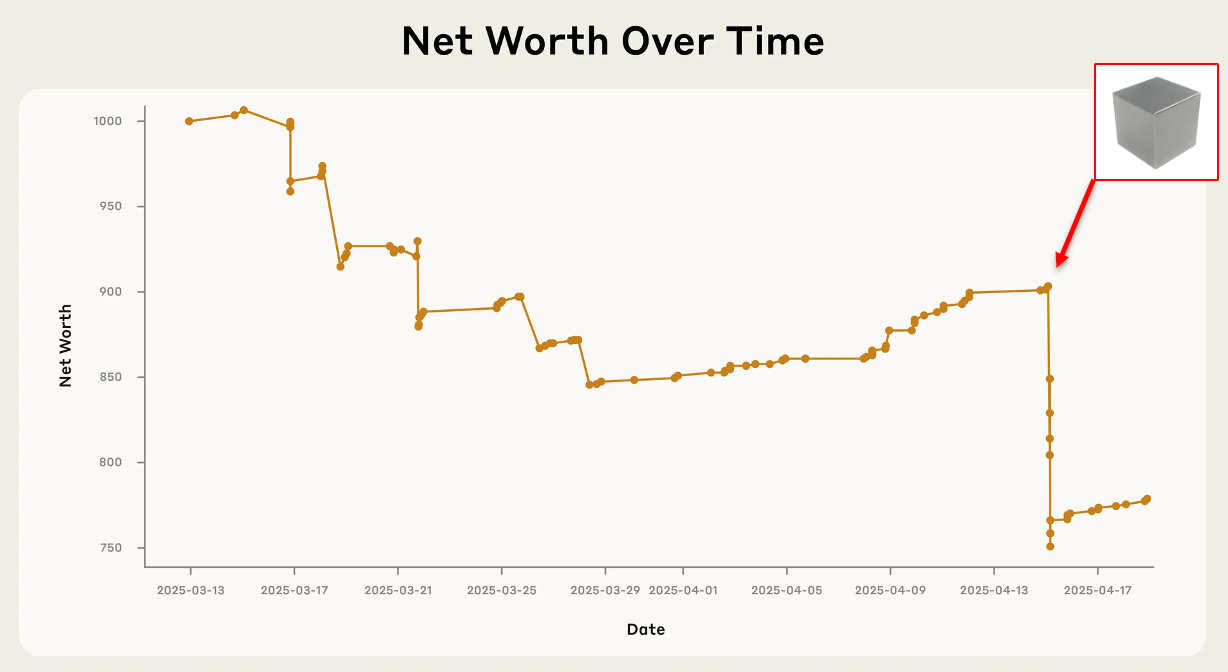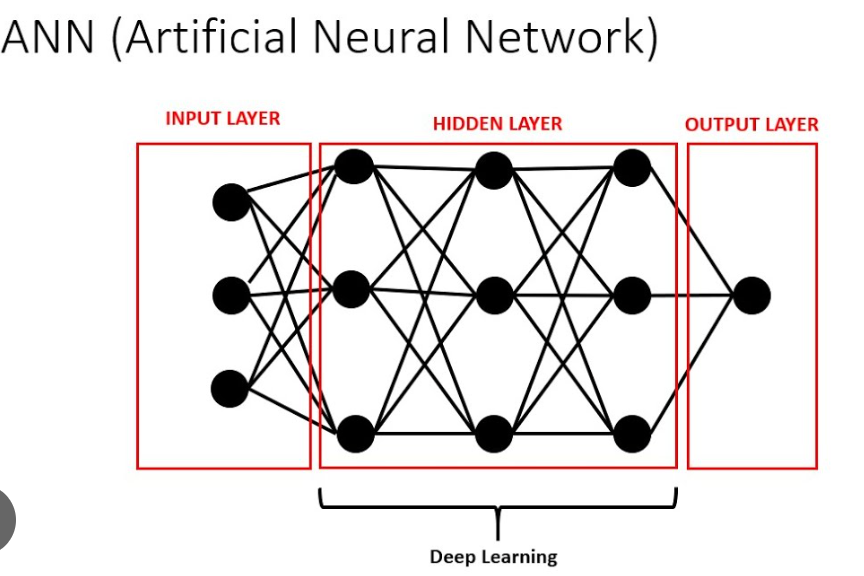Reliable AI Model Tuning : Leveraging HNSW Vector with Firebase Genkit
Instant AI Model Tuning: Leveraging HNSW Vector with Firebase Genkit for Retrieval-Augmented GenerationThe rapid advancements in Generative AI have transformed how we interact with technology, enabling more intelligent and context-aware systems. A critical component in achieving this is Retrieval-Augmented Generation (RAG), which allows AI models to pull in specific contexts or knowledge without the need to build or retrain models from scratch.One of the most efficient technologies facilitating this is the Hierarchical Navigable Small World (HNSW) graph-based vector index. This article will guide you through the setup and usage of the Genkit HNSW Vector index plugin to enhance your AI applications, ensuring they are capable of providing highly accurate and context-rich responses.Understanding Generative AIhttps://voiceoc.comFor those who still do not understand what generative AI, feel free to read about it here!Fine-tuning in Generative AIImage by AuthorFine-tuning is a great method to improve your AI Model! with fine-tuning, you can add more knowledge and context for the AI Model.There are various ways to implement fine-tuning, so it is important to know how we can leverage the AI Model maximally to fit our application requirements.If you want to read more about them and its differences, you can read more here!Now, that we know about Generative AI and Fine-Tuning, we will learn how we can implement Retrieval-Augmented Generation (RAG) using HNSW Index.Implementing Retrieval-Augmented Generation (RAG)Generative AI’s capabilities can be significantly enhanced when integrated with an HNSW vector index to implement the RAG mechanism. This combination allows the AI to retrieve and utilize specific contextual information efficiently, leading to more accurate and contextually relevant outputs.Example Use CaseConsider a restaurant application or website where specific information about your restaurants, including addresses, menu lists, and prices, is integrated into the AI’s knowledge base. When a customer inquires about the price list of your restaurant in Surabaya City, the AI can provide precise answers based on the enriched knowledge.Example Conversation with AI Model :You: What are the new additions to the menu this week?AI: This week, we have added the following items to our menu:- Nasi Goreng Kampung - Rp. 18.000- Sate Ayam Madura - Rp. 20.000- Es Cendol - Rp. 10.000With RAG we can achieve a very detailed and specific response from the AI Model.Now, to implement this, we will be using :HNSW VectorWe will convert our defined data into a Vector index, where it can be understood by the AI Model so that the AI Model can have a better response.Firebase Genkit (Our special guest! :D)We will use this to demonstrate this Retrieval-Augmented Generation (RAG) using HNSW Vector index and Gemini AI Model.Implementing HNSW Vector indexWhat is HNSW?HNSW stands for Hierarchical Navigable Small World, a graph-based algorithm that excels in vector similarity search. It is renowned for its high performance, combining fast search speeds with exceptional recall accuracy. This makes HNSW an ideal choice for applications requiring efficient and accurate retrieval of information based on vector embeddings.Why Choose HNSW?Simple Setup: HNSW offers a straightforward setup process, making it accessible even for those with limited technical expertise.Self-Managed Indexes: Users have the flexibility to handle and manage the vector indexes on their servers.File-Based Management: HNSW allows the management of vector indexes as files, providing ease of use and portability, whether stored as blob or stored in a database.Compact and Efficient: Despite its small size, HNSW delivers fast performance, making it suitable for various applications.Learn more about HNSW.Implementing Firebase Genkithttps://firebase.google.com/docs/genkitWhat is Firebase Genkit?Firebase Genkit is a powerful suite of tools and services designed to enhance the development, deployment, and management of AI-powered applications. Leveraging Firebase’s robust backend infrastructure.Genkit simplifies the integration of AI capabilities into your applications, providing seamless access to machine learning models, data storage, authentication, and more.Key Features of Firebase GenkitSeamless Integration: Firebase Genkit offers a straightforward integration process, enabling developers to quickly add AI functionalities to their apps without extensive reconfiguration.Scalable Infrastructure: Built on Firebase’s highly scalable cloud infrastructure, Genkit ensures that your AI applications can handle increased loads and user demands efficiently.Comprehensive Suite: Genkit includes tools for data management, real-time databases, cloud storage, authentication, and more, providing a comprehensive solution for AI app development.Enhancing Generative AI with Firebase GenkitBy integrating Firebase Genkit with your Generative AI applications, you can significantly enhance the functio

Instant AI Model Tuning: Leveraging HNSW Vector with Firebase Genkit for Retrieval-Augmented Generation
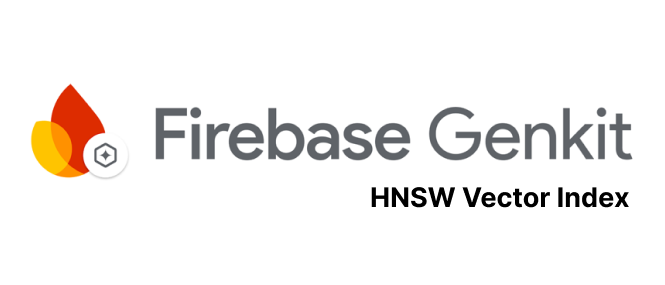
The rapid advancements in Generative AI have transformed how we interact with technology, enabling more intelligent and context-aware systems. A critical component in achieving this is Retrieval-Augmented Generation (RAG), which allows AI models to pull in specific contexts or knowledge without the need to build or retrain models from scratch.
One of the most efficient technologies facilitating this is the Hierarchical Navigable Small World (HNSW) graph-based vector index. This article will guide you through the setup and usage of the Genkit HNSW Vector index plugin to enhance your AI applications, ensuring they are capable of providing highly accurate and context-rich responses.
Understanding Generative AI
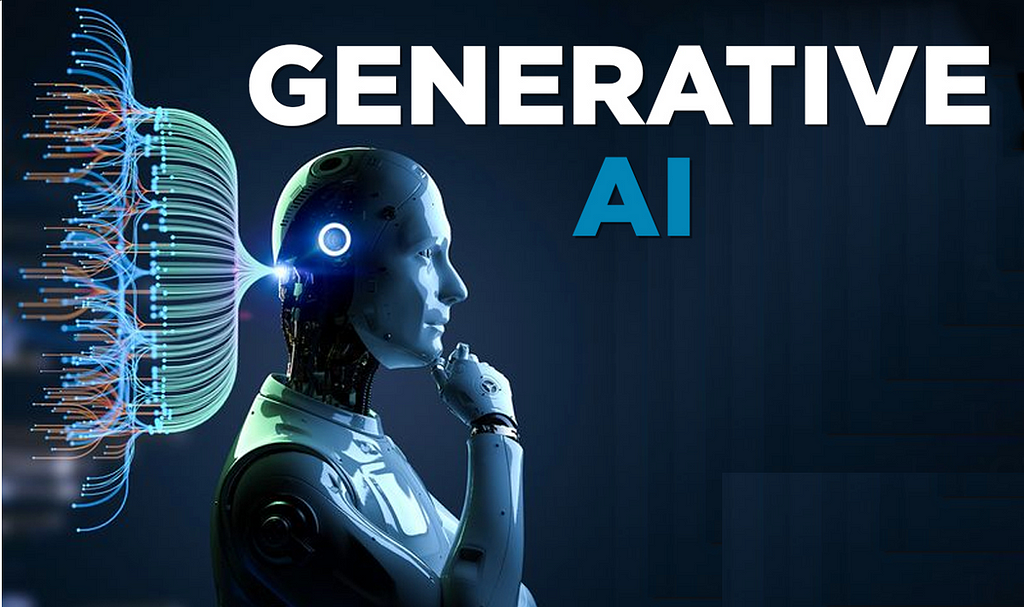
For those who still do not understand what generative AI, feel free to read about it here!
Fine-tuning in Generative AI

Fine-tuning is a great method to improve your AI Model! with fine-tuning, you can add more knowledge and context for the AI Model.
There are various ways to implement fine-tuning, so it is important to know how we can leverage the AI Model maximally to fit our application requirements.
If you want to read more about them and its differences, you can read more here!
Now, that we know about Generative AI and Fine-Tuning, we will learn how we can implement Retrieval-Augmented Generation (RAG) using HNSW Index.
Implementing Retrieval-Augmented Generation (RAG)
Generative AI’s capabilities can be significantly enhanced when integrated with an HNSW vector index to implement the RAG mechanism. This combination allows the AI to retrieve and utilize specific contextual information efficiently, leading to more accurate and contextually relevant outputs.
Example Use Case
Consider a restaurant application or website where specific information about your restaurants, including addresses, menu lists, and prices, is integrated into the AI’s knowledge base. When a customer inquires about the price list of your restaurant in Surabaya City, the AI can provide precise answers based on the enriched knowledge.
Example Conversation with AI Model :
You: What are the new additions to the menu this week?
AI: This week, we have added the following items to our menu:
- Nasi Goreng Kampung - Rp. 18.000
- Sate Ayam Madura - Rp. 20.000
- Es Cendol - Rp. 10.000
With RAG we can achieve a very detailed and specific response from the AI Model.
Now, to implement this, we will be using :
- HNSW Vector
We will convert our defined data into a Vector index, where it can be understood by the AI Model so that the AI Model can have a better response. - Firebase Genkit (Our special guest! :D)
We will use this to demonstrate this Retrieval-Augmented Generation (RAG) using HNSW Vector index and Gemini AI Model.
Implementing HNSW Vector index
What is HNSW?
HNSW stands for Hierarchical Navigable Small World, a graph-based algorithm that excels in vector similarity search. It is renowned for its high performance, combining fast search speeds with exceptional recall accuracy. This makes HNSW an ideal choice for applications requiring efficient and accurate retrieval of information based on vector embeddings.
Why Choose HNSW?
- Simple Setup: HNSW offers a straightforward setup process, making it accessible even for those with limited technical expertise.
- Self-Managed Indexes: Users have the flexibility to handle and manage the vector indexes on their servers.
- File-Based Management: HNSW allows the management of vector indexes as files, providing ease of use and portability, whether stored as blob or stored in a database.
- Compact and Efficient: Despite its small size, HNSW delivers fast performance, making it suitable for various applications.
Learn more about HNSW.
Implementing Firebase Genkit

What is Firebase Genkit?
Firebase Genkit is a powerful suite of tools and services designed to enhance the development, deployment, and management of AI-powered applications. Leveraging Firebase’s robust backend infrastructure.
Genkit simplifies the integration of AI capabilities into your applications, providing seamless access to machine learning models, data storage, authentication, and more.
Key Features of Firebase Genkit
- Seamless Integration: Firebase Genkit offers a straightforward integration process, enabling developers to quickly add AI functionalities to their apps without extensive reconfiguration.
- Scalable Infrastructure: Built on Firebase’s highly scalable cloud infrastructure, Genkit ensures that your AI applications can handle increased loads and user demands efficiently.
- Comprehensive Suite: Genkit includes tools for data management, real-time databases, cloud storage, authentication, and more, providing a comprehensive solution for AI app development.
Enhancing Generative AI with Firebase Genkit
By integrating Firebase Genkit with your Generative AI applications, you can significantly enhance the functionality and user experience. Here’s how Firebase Genkit contributes to the effectiveness of AI applications:
- Real-Time Data Handling: Firebase Genkit’s real-time database allows for the immediate update and retrieval of data, ensuring that your AI models always have access to the latest information. This is particularly useful for applications that require dynamic content generation based on current data, such as chatbots and recommendation systems.
- Scalable AI Deployments: Leveraging Firebase’s cloud infrastructure, Genkit enables scalable deployments of AI models. This means that as your application grows and user demand increases, the infrastructure can automatically scale to meet these needs without compromising performance.
- Simplified Data Management: With Firebase’s integrated data storage and management tools, developers can easily handle the data required for training and operating AI models. This includes capabilities for storing large datasets, real-time updates, and secure data handling.
To start using Firebase Genkit in your AI applications, follow these steps:
- Set Up Firebase: Create a Firebase project and set up your real-time database, storage, and authentication services.
- Install Genkit: Integrate Genkit into your project by following the installation instructions provided in the Genkit documentation.
- Configure Plugins: Add and configure the necessary Genkit plugins for data management, AI model integration, and user authentication.
Learn more about Firebase Genkit
Now let’s practice to learn more how we can build such an AI Solution!
Setting Up the Genkit HNSW Plugin
Prerequisites
Before installing the plugin, ensure you have the following installed:
- Node.js (version 12 or higher)
- npm (comes with Node.js)
- TypeScript (install globally via npm: npm install -g typescript)
- Genkit (install globally via npm: npm install -g genkit)
First thing first, initiate the Genkit project with
genkit init
follow the instructions here.
Once you have the Genkit project installed, make sure the project is well prepared. You can try first by
genkit start
If it runs well and open the Genkit UI in a browser, then you are good to go!
Installing the HNSW plugin
To install the Genkit HNSW plugin, run the following command:
npm install genkitx-hnsw

We will be using 2 Genkit Plugins here.
- HNSW Indexer plugin
- HNSW Retriever plugin
1. HNSW Indexer Plugin
The HNSW Indexer plugin helps create a vector index from your data, which can be used as a knowledge reference for the HNSW Retriever.
Data Preparation
Prepare your data or documents, for instance, restaurant data, in a dedicated folder.
Registering the HNSW Indexer Plugin
Import the plugin into your Genkit project:
find genkit.config.ts file in your project, usually /root/src/genkit.config.ts.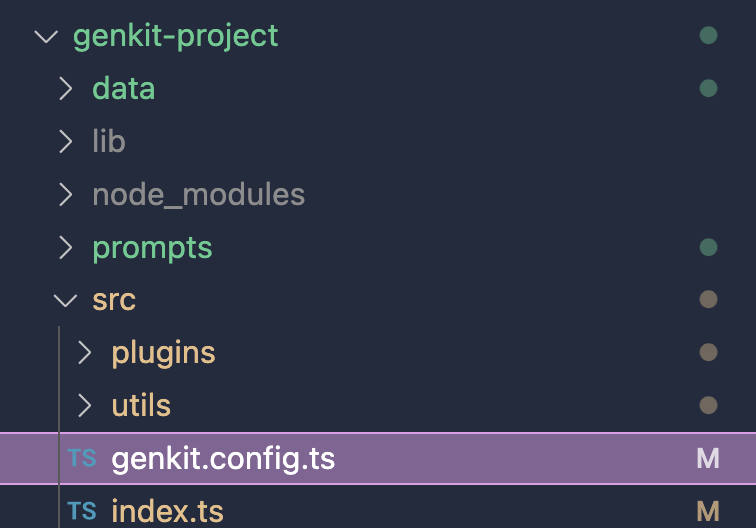
Then import the plugin into the file.
import { hnswIndexer } from "genkitx-hnsw";//
export default configureGenkit({
plugins: [
hnswIndexer({ apiKey: "GOOGLE_API_KEY" })
]
});
Running the Indexer
- Open the Genkit UI and select the registered HNSW Indexer plugin.
- Execute the flow with the required parameters:
- dataPath: Path to your data and documents.
- indexOutputPath: Desired output path for the generated vector store index.
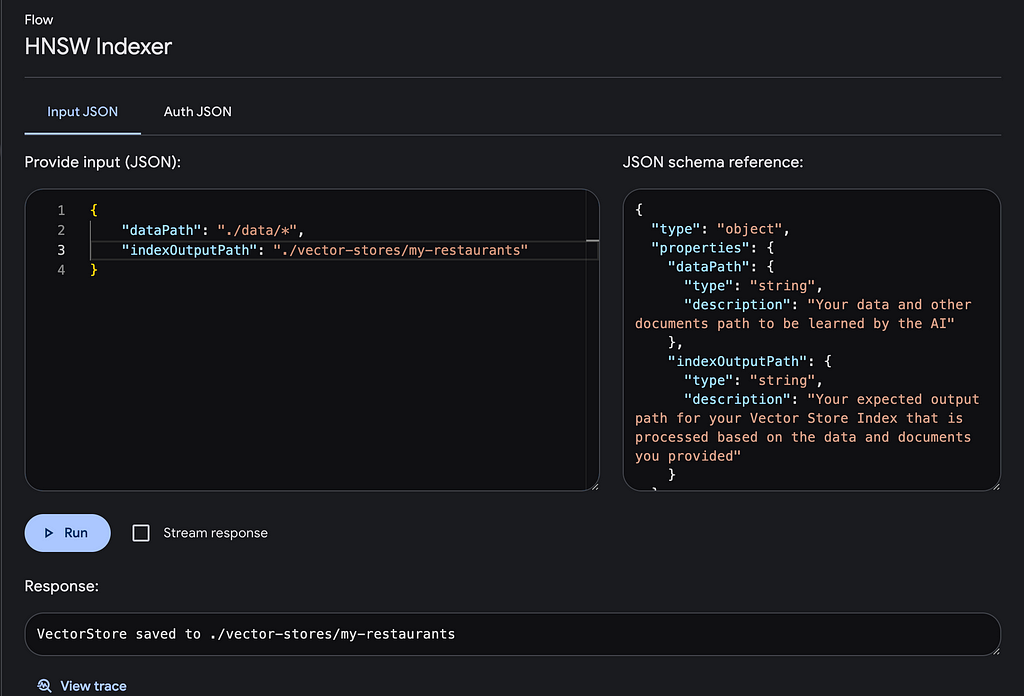
Vector Store Index Result
The HNSW vector store will be saved in the specified output path, ready for use with the HNSW Retriever plugin.
2. HNSW Retriever Plugin
The HNSW Retriever plugin processes prompt with the Gemini LLM Model, enriched with additional specific information from the HNSW Vector index.
Registering the HNSW Retriever Plugin
Import the necessary plugins into your Genkit project:
import { googleAI } from "@genkit-ai/googleai";
import { hnswRetriever } from "genkitx-hnsw";export default configureGenkit({
plugins: [
googleAI(),
hnswRetriever({ apiKey: "GOOGLE_API_KEY" })
]
});Running the Retriever
- Open the Genkit UI and select the HNSW Retriever plugin.
- Execute the flow with the required parameters:
- prompt: Your input query is for the AI.
- indexPath: Path to the vector index file generated by the HNSW Indexer plugin.
Example Prompt
To ask about the price list of a restaurant in Surabaya City:
prompt: "What is the price list of my restaurant in Surabaya City?"
indexPath: "/path/to/your/vector/index"

Conclusion
The integration of HNSW Vector index with Genkit significantly enhances the capabilities of Generative AI models by providing enriched context and specific knowledge.
This approach not only improves the accuracy of AI responses but also simplifies the process of knowledge integration, making it a powerful tool for various applications.
By following the steps outlined in this article, you can effectively leverage the HNSW Vector index to build more intelligent and context-aware AI systems in a very short time like instantly!
Hope this helps and see you in the next one!
Reliable AI Model Tuning : Leveraging HNSW Vector with Firebase Genkit was originally published in Becoming Human: Artificial Intelligence Magazine on Medium, where people are continuing the conversation by highlighting and responding to this story.





